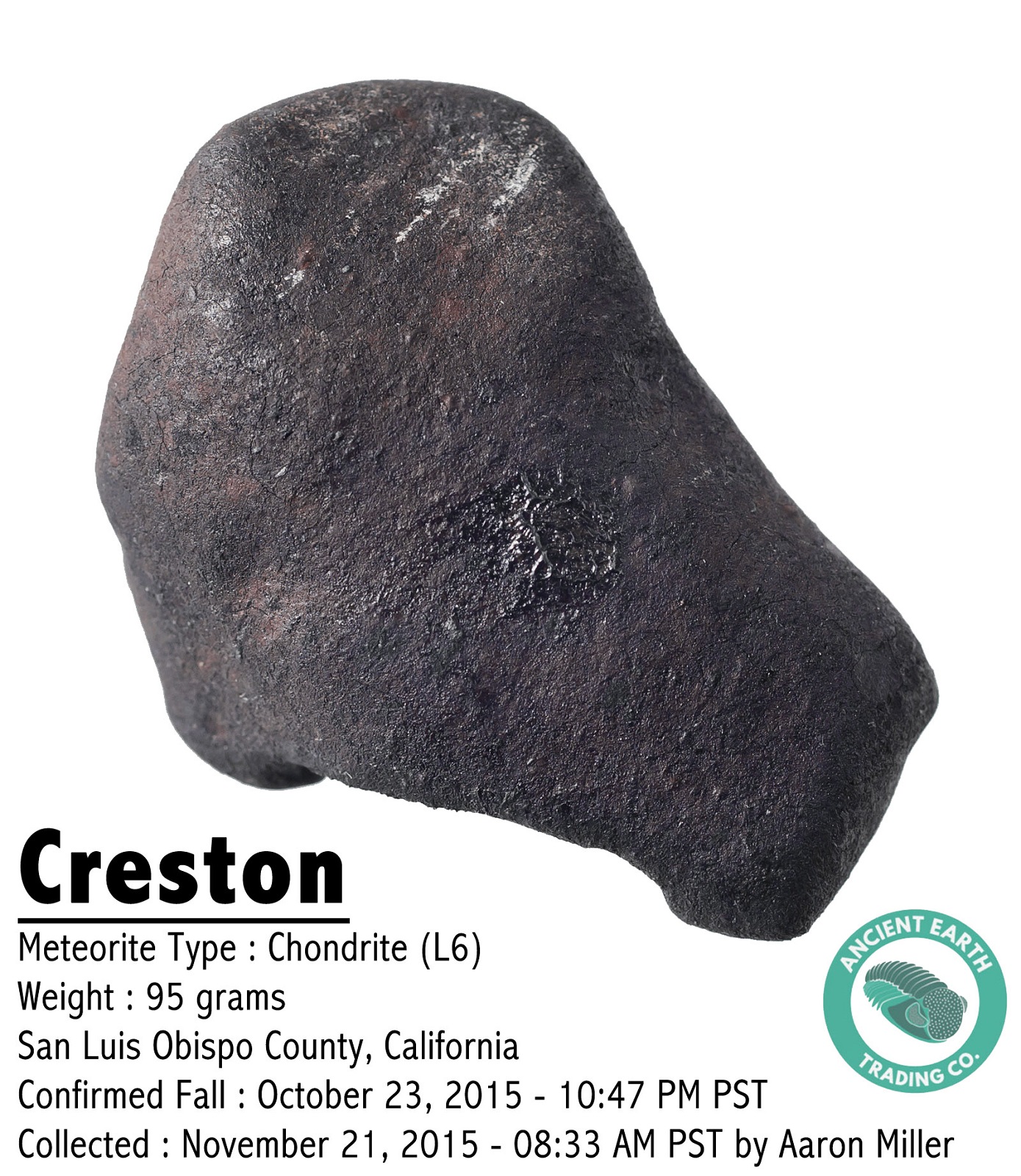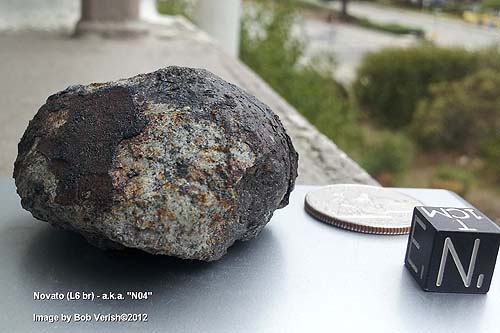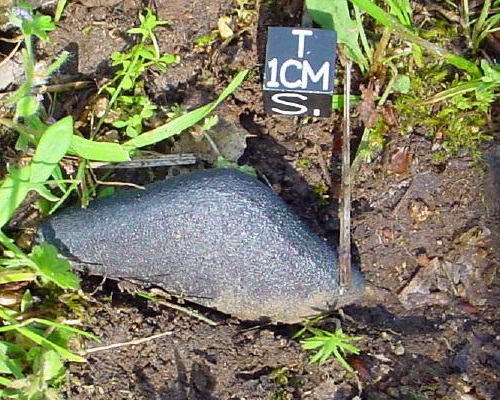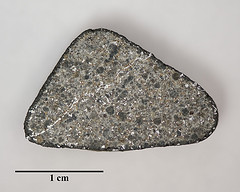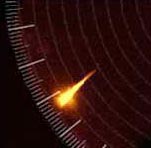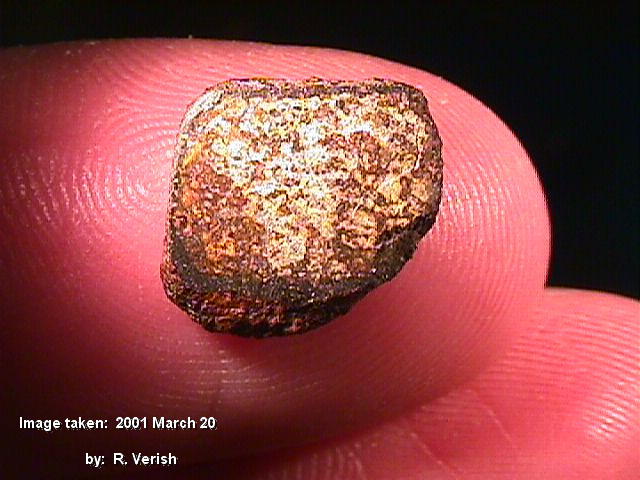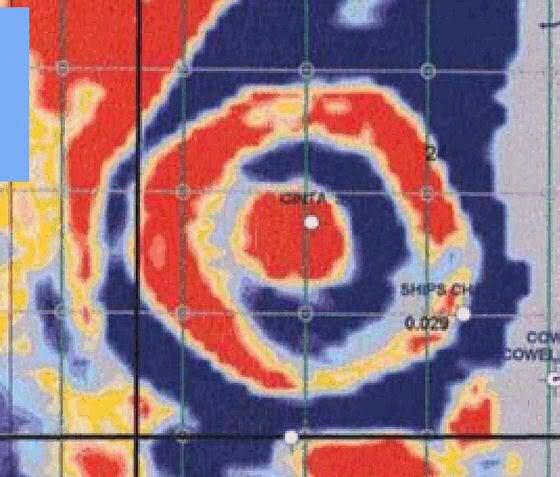|
California Meteorite Finds (NOT found on dry lakes)Source: Meteoritical Bulletin Database
Lake
Los Angeles (b) - Ordinary chondrite (classified by UCLA: L6 S4 W1 Fa24.7±0.2);
Writeup from MB 103: Lake Los Angeles - Ordinary chondrite (classified by UCLA: H6 S2 W2 Fa18.9±0.4); A single stone fragment (92 mm × 70 mm × 57 mm) Blackhawk Mountain - Ordinary chondrite (H4 S2 W0 Fa20.9±0.2); A solitary stone (20.16g) was found by Michael Mulgrew on 2012 Oct 20th 12:30pm PDT, while searching for meteorites on the surface of the Blackhawk Landslide (essentially an abandoned alluvial surface), which is located in Lucerne Valley, San Bernardino County. Probably the first meteorite found on a landslide. Rosamond - Unequilibrated Ordinary Chondrite (LL3); found by Robert Verish on June 9, 2012, while searching for meteorites in an empty lot on the outskirts of the town of Rosamond (Kern County). Johannesburg - Ordinary chondrite (H4 S2 W5 Fa18.6±0.1 [n=8]); Found by David Libuszowski on 2012 January 27th, while exploring in the Johannesburg area (Kern County) with his dad. The meteorite (a single 63gram stone) was found partially exposed on a sandy slope.; classified by Alan Rubin, UCLA. San Bernardino Wash - Find 2010. Ordinary chondrite (L5); Bob Perkins of Highland, California found the first and second stones while metal-detecting for gold with Gary Crabtree near the "Rusty Gold Mine," in the Dale Mining District (Riverside County).
Willow Wash - Find 2006 September 14. H3.5, breccia; S3 W2. Fa =12.8-30.9. 552 g. A single stone, fully crusted. 35°22'24.88"N, 115°20'37.95"W. Main mass with finder S. Humeston. Randsburg - Find 2005 Jan 2. L5 (S2, W1), 112.9g stone, found by E. Melchiorre. Chicago Valley - Find 2004 December 27 . L5, S1 W3. Fa = 24.8, Fo = 20.9. 26g. Found by S. Clary at 36°00.13'N, 116°11.78'W on desert pavement. Chocolate Mountains - Find 2004. A ureilite. A 699 g stone was found at the base of Black Mountain by Bill Sajkowicz. Paymaster Mine - Find 2004 October 10. L5, Fa = 25.0, Fs = 21.5. 159g. Found by J. Pringle in desert at the base of a hill: 33°11.2'N, 114°55.07'W. Winterhaven - Find 2002 or 2003. Howardite, Fs=33.5-21.8, Wo=1.3-40.8. 2.1 kg. Found by B. Sajkowicz in Imperial County: 32°57'N, 114°40'W. Essex - Find 2002 Febr 24. H5; Fa = 18.9. 5 kg. Found by S. Ellis in San Bernadino county: 34°36.7'N, 115°2.0'W. Cargo Muchacho Mountains - Find ~2000. CO3. 2860 g The 35 stone strewn-field was mapped by finder, Bill Sajkowicz, in Imperial County. Supersition Mountain - Find 2000 August 15. H5; Fa = 18.9. 333 g. Found by N. Gessler in Imperial County: 32°52'15"N, 115°46'57"W. Old Dominion Mine - Find 2000 October 13. H4; Fa=19.8. 42 g. Found by J. Tobin in San Bernardino county: 34°51.575'N, 116°13.268'W.
Bruceville - Find 1998. L6; Fa = 24.6, S5 W4. 83 kg. Found by B. Howard in Sacramento county: 38°17.7'N, 121°24.3'W. Was buried under about 2 meters of silt and loam. Chuckwalla - Find 1992-November. IAB-MG. 1802g. Found in Kern County, CA. 35°15'N, 118°16'W. A single mass of 1.802 kg was found by Mr. Melvin English while quail hunting in the foothills of the Tehachapi Mountains. Classification IAB-MG. The meteorite contains diamonds, some visible macroscopically, and many visible under the microscope. From: Meteoritical Bulletin 87. Ocotillo - Find 1990. IAB-MG (main group). 28.57 kg. Found by Bill Hanna about 5 miles N. of Ocotillo in Imperial County. Main mass with James Schwade in Kankakee, Il. Somesbar - Find 1977. H6. 60g (approx.). Found in Siskiyou County: 41°23'N, 123°30'W. Found by a geologist. 38g at Center for Meteorite Studies, Tempe, Arizona.
Zulu Queen - Find 1976. L3.7. 200 g. Dale mining district, Pinto Mountains, Riverside County, CA. 18 miles ESE of Twentynine Palms and five miles W. of the Zulu Queen mine. 33o59'N, 115o41'W. Found by the late Mrs. Alice Zimmerman while prospecting in the Pinto Mountains. This stone is distinct from the Pinto Mountains stone, an L6 chondrite, but is indistinguishable from the Dale Dry Lake chondrite, an L3.7 stone. Red Rock - Find 1976. IIIAB. 47.6 kg. Found near Red Rock Canyon State Park, Kern County, CA. 35°25'N, 117°55'W. Found about 1976 by R. K. Haag while hunting for rabbits. Entire mass purchased by the University of California, Los Angeles. Source: Meteoritical Bulletin 68. Needles - Find 1962 Find. IID. 45.3 kg. Location: 34°26'39"N, 114°49'57"W. Also called "Carsons Well". Ridgecrest - Find 1958 May. H5; S2, W2, Fa = 18.6. 9.7 g. san Bernadino County, CA: 35°35'N, 117°34'W. Not paired with Muroc. Meteorite is of oriented shape. Dale Dry Lake - Find 1957. L3.7. 300 g. San Bernardino County, CA: 34°05'N, 115°47'W. (Although named after a nearby dry lake, it was actually found 13 miles away (to the southwest) in Riverside County.) Pinto Mountains - Find 1954. L6. 17.9 kg. Ref.: Meteoritics 1, 1955, p. 295. Location: 34°00'N, 115°47'W (source: MB 65). An additional 19kg main-mass was found by the same finder (Vincenz Zimmerman) in 1955 and is known as the "Twentynine Palms (1955 stone)". (Source: R.Verish) Ventura - FInd 1953. IAB-ung. 7.7 kg. 34°15'N, 119°18'W. Neenach - Find 1948. L6. 13.8 kg. Location: 34°48'N, 118°30'W. Ref.: Griffith Observer, 17, 80-82; Meteoritics 1, 1953, 28. Twentynine Palms - Find 1944. L. 100g. San Bernardino County. 34°04.5'N, 116°01'W. (Cataloge of Meteorites, M. Grady, 2000) Goose Lake - Find 1938. IAB-sLL. 1.17 MT. Borrego - Find 1930. L6; S4 W1; Fa=25.1. 2.13 kg. Found in San Diego county. Supposedly found by an anonymous rockhound, according to third-hand sources. Recognized in 2001 while in an estate sale in Texas. Valley Wells - Find 1929. L6 129.9g. 35°28'N, 115°40'W. Owens Valley - Find 1913. IIIAB. 192.8 kg. 37°28'N, 118°00'W. Imperial - Find 1908. H4. 4g. 32°52'N, 115°35'W. Surprise Springs - Find 1899. IAB-sLL. 1500 g. 34°10'N, 115°55'W. Oroville - Find 1893. IIIAB. 24.5 kg. 39°41'N, 121°38'W. San Emigdio - Find 1887. H4. 36 kg. 36°N, 119°W. Ivanpah - Find 1880. IIIAB. 58 kg. 35°20'N, 115°19'W. Canyon City - Find 1875. III AB. 8.6 kg. 40°54'N, 123°6'W. Shingle Springs - Find 1869. Iron-ung. 39 kg. 38°40'N, 120°56'W. California Meteorite Finds (From Dry Lakes)Buckhorn Lake - Find 2008. H4 S2 W5 Fa=17.0+/-0.2%. TKW = 14.1g (MB#103) Coyote Dry Lake (CyDL) table compiled by Meteoritical Bulletin:
Cuddeback Dry Lake table compiled by Meteoritical Bulletin:
Emerson Dry Lake - Find 2006. L6. 32g. (MB#102)
Goldstone Dry Lake - Find 1999. H6. 1.1g.
Harper Dry Lake (HrDL) - finds as compiled by the Meteoritical Society in their Meteoritical Bulletin.
Ivanpah Dry
Lake - Find: 2014 January 1st. H4. 1128g. (MB#104)
[Editorial comments: based upon the above information, the entry for Ivanpah Dry Lake in the Met. Bulletin should be revised to reflect the following corrections: Even if you assume that the "both halves" are physically-paired, then "Pieces" should still be changed to "2". If the two halves are indeed "physically-paired" that fact and those words should appear in "Physical characteristics".
Lucerne Valley
(LV) -
Additional Lucerne Valley
finds (all were found on the dry lake) compiled by Meteoritical Bulletin:
Muroc - Find 1936. L. 18.4 g. Now part of Edwards AFB.
Muroc Dry Lake - 1936. Find L6. 223 g. Now part of Edwards AFB.
Rosamond Dry Lake - Find 1940. L. 850 g. Now part of Edwards AFB.
Sheephole Valley - Find 1999. H4. 62.1g.
Silurian Dry Lake - Find 2000. LL6. 43.8 g.
Silver Dry Lake 001 - Find 2000. L4. 219 g. (MB#85)
Sunfair - Find 2006. L6. 49.8 g. (MB#102)
Sunfair 002 - Find 2013. L-chondrite (prov.). 19.4 g.
Superior Valley (SuV) - Find. Table compiled by Meteoritical Bulletin:
Stewart Valley (StV) - Finds. Table compiled by Meteoritical Bulletin:
Troy Dry Lake 34°48.53’N, 116°33.05’W California, United States Find: 2017 Apr 7 Classification: Ordinary chondrite (L6) History: A single 16.3 g stone was found by Mark Bittmann on April 7, 2017, while he was searching for meteorites on a dry lake. Subsequent searches resulted in no additional fragments or other meteorites. Physical characteristics: Dark-brown, flat shield-shaped fragment with moderately rounded edges, and patches of relict fusion-crust that have developed a desert-polished patina. Petrography: (D. Sheikh, FSU) Chondrule boundaries blurred. Recrystallized coarse-grained matrix with plagioclase (60um). Interconnected shock melt veins. Geochemistry: Olivine, Fa24.7±0.2 (N=26); orthopyroxene, Fs22.3±0.2Wo2.7±0.2(N=25). Classification: Ordinary Chondrite (L6) Specimens: 3.5 grams at UCLA; main mass with Verish.
|

